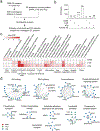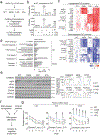Alzheimer's disease-associated U1 snRNP splicing dysfunction causes neuronal hyperexcitability and cognitive impairment
- PMID: 36636325
- PMCID: PMC9833817
- DOI: 10.1038/s43587-022-00290-0
Alzheimer's disease-associated U1 snRNP splicing dysfunction causes neuronal hyperexcitability and cognitive impairment
Abstract
Recent proteome and transcriptome profiling of Alzheimer's disease (AD) brains reveals RNA splicing dysfunction and U1 small nuclear ribonucleoprotein (snRNP) pathology containing U1-70K and its N-terminal 40-KDa fragment (N40K). Here we present a causative role of U1 snRNP dysfunction to neurodegeneration in primary neurons and transgenic mice (N40K-Tg), in which N40K expression exerts a dominant-negative effect to downregulate full-length U1-70K. N40K-Tg recapitulates N40K insolubility, erroneous splicing events, neuronal degeneration and cognitive impairment. Specifically, N40K-Tg shows the reduction of GABAergic synapse components (e.g., the GABA receptor subunit of GABRA2), and concomitant postsynaptic hyperexcitability that is rescued by a GABA receptor agonist. Crossing of N40K-Tg and the 5xFAD amyloidosis model indicates that the RNA splicing defect synergizes with the amyloid cascade to remodel the brain transcriptome and proteome, deregulate synaptic proteins, and accelerate cognitive decline. Thus, our results support the contribution of U1 snRNP-mediated splicing dysfunction to AD pathogenesis.
Figures















References
Publication types
MeSH terms
Substances
Grants and funding
- P30 AG072975/AG/NIA NIH HHS/United States
- RF1 AG068581/AG/NIA NIH HHS/United States
- P30 AG010161/AG/NIA NIH HHS/United States
- U19 AG069701/AG/NIA NIH HHS/United States
- U24 NS072026/NS/NINDS NIH HHS/United States
- P30 AG019610/AG/NIA NIH HHS/United States
- R01 MH095810/MH/NIMH NIH HHS/United States
- R01 AG047928/AG/NIA NIH HHS/United States
- R01 AG017917/AG/NIA NIH HHS/United States
- R01 AG053987/AG/NIA NIH HHS/United States
- P30 AG072980/AG/NIA NIH HHS/United States
- U54 NS110435/NS/NINDS NIH HHS/United States
- RF1 AG064909/AG/NIA NIH HHS/United States
- R01 MH097742/MH/NIMH NIH HHS/United States
- R01 AG015819/AG/NIA NIH HHS/United States
LinkOut - more resources
Full Text Sources
Medical
Molecular Biology Databases
Research Materials
Miscellaneous

